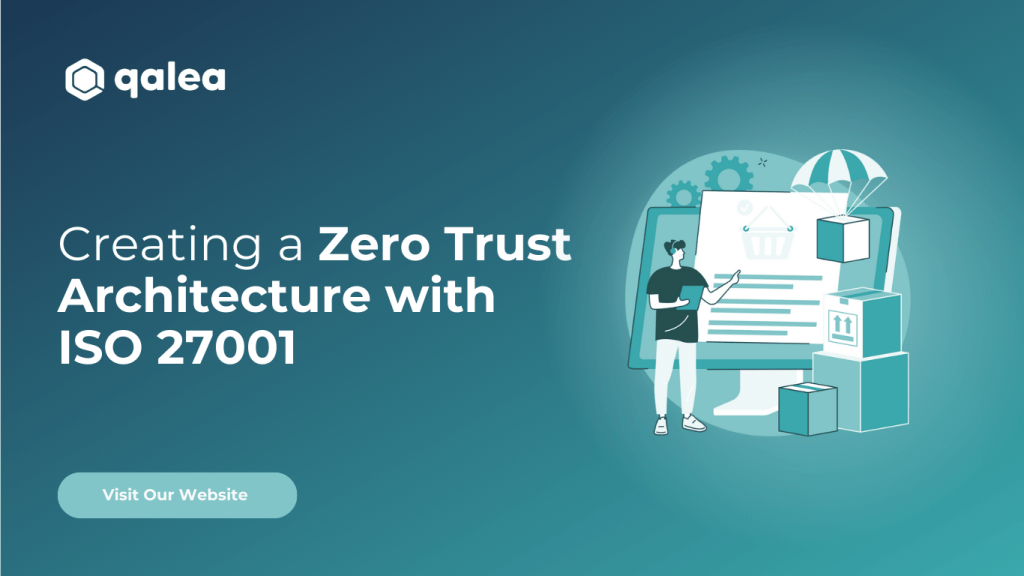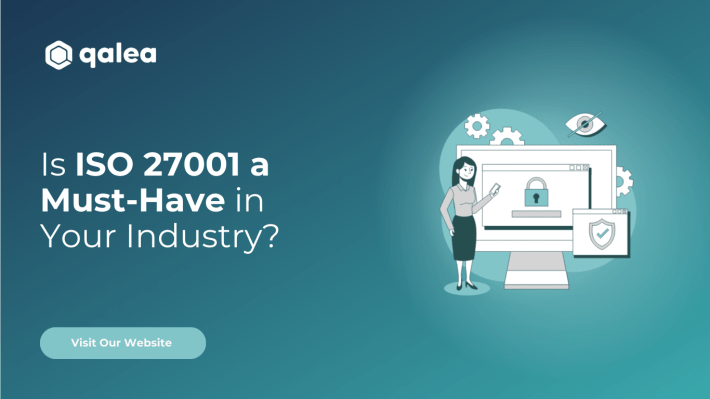Creating a Zero Trust Architecture with ISO 27001

Two powerful tools that can help you manage the security of your organization better are ISO 27001 and the Zero Trust Framework. The Zero Trust Framework emphasizes never trusting anyone and always validating. It ensures that every authentication request made by anyone is properly validated. Only relevant and authorized persons should be allowed to access resources and data. On the other hand, ISO 27001 is an internationally recognized standard for information security management systems (ISMS). These are a set of rules that guide organizations of every size in the establishment, implementation, and maintenance of an information security management system.
Combining Zero Trust Architecture (ZTA) with ISO 27001 provides a comprehensive security solution. While ZTA offers a modern and proactive approach to access control and threat prevention, ISO 27001 provides a structured framework for implementing and maintaining an information security management system. Together, they create a resilient defense against the ever-changing threat landscape, ensuring that organizations can protect their assets and maintain trust with their stakeholders. However, this synergy not only enhances the cybersecurity posture but also ensures compliance with global standards, making it a compelling choice for forward-thinking organizations.
Zero Trust Made Simple
Zero Trust implies ‘never trust, always verify.’ This means that no one, whether inside or outside an organization, should be able to access resources or data without proper authorization. Every attempt to access data must be properly authorized.
Core principles of Zero Trust
The following are the core principles of Zero Trust:
- Explicit Verification: Identification and verification of access permissions are required before granting access to any user.
- Least Privilege Access: A user must be given the minimum privileges necessary to perform a specific action.
- Assume Breach: Always assume that a breach has occurred and set limitations accordingly.
Building blocks of Zero Trust Architecture
The following are the building blocks of Zero Trust Architecture:
- Identity and Access Management (IAM): IAM ensures that only authorized persons are granted access to certain resources. Most cloud providers nowadays offer IAM capabilities to ensure that cloud resources are managed by authorized and relevant individuals only. Combining a password manager like LastPass or 1Password with Google Workspace’s basic IAM principles helps manage and secure credentials while ensuring that cloud resources are accessed only by relevant individuals.
- Micro-segmentation: An organization’s network should be segmented into smaller parts so that in case of a breach or attack, it can be contained within that segment of the network only. For example, VMware NSX provides capabilities to segment networks by creating security policies to restrict access among networks.
- Multi-factor Authentication (MFA): Multiple authentication mechanisms should be in place to verify a user before allowing access to certain resources. Duo Security or Microsoft authenticator provides a mechanism to authenticate based on a generated code as an extra layer of authentication.
- Encryption: Data must be encrypted both at rest and in transit. Bitlocker is a tool of Microsoft that encrypts data at rest while TLS and VPNs ensure that data in transit is encrypted properly.
- Continuous Monitoring: All user activities must be monitored so that any anomalies can be identified and remediated accordingly. Tools like splunk and Azure security center provide capabilities to monitor user activities and network traffic.
Advantages of Zero Trust Architecture
There are several advantages for an organization to adopt the zero trust architecture.
- By verifying every attempt made by a user or device to access a resource within the network, the risk of unauthorized access is significantly reduced.
- Micro-segmentation helps contain breaches and prevent them from spreading. There could be many approaches to implement this. For example, each department of an organizaiton can operate into their own smaller network. In case one department is effected by breach, the impact can be contained within that chunk of network.
- It helps meet compliance requirements by enforcing strict access controls and monitoring. For example, regulations like GDPR and HIPAA require that no unauthorized person should be able to access the data.
Challenges of Implementing Zero Trust Architecture
Although Zero Trust provides substantial protection against unauthorized access, it comes with some challenges:
- ZTA requires significant changes in IT infrastructure.
- It requires an initial investment in technology and training.
- If MFA is not implemented smoothly, it can be cumbersome for end users and impact their user experience.
What is ISO 27001 and Why is it Important?
ISO 27001 is the international standard for Information Security Management System (ISMS). It ensures the confidentiality, integrity and availability of an organization’s sensitive information by providing a framework. Imagine a company having a databreach. Sensitive customer information is leaked, causing financial loss and reputational damage. All this can be avoided by having proper security measures in place. ISO 27001 provides such framework. Its not about ticking the boxes but it enforces the culture of security in your organization.
Key Elements of ISO 27001:
- Risk Assessment and Treatment: Identification of potential security risks and mitigation using appropriate controls. This proactive approach helps identify and mitigate vulnerabilities before they do damage to organization.
- Security Policy: Information security management is achieved by establishing a comprehensive policy that outlines the organizations approach to manage the security of critical assets. Having a policy in place ensures the consistency around the organization.
- Asset Management: Ensuring protection by keeping track of information assets. This can include both hardware and software assets. Knowing what data that you have and where it is stored can help prioritize protection of critical data.
- Access Control: Implementing the principle of least privilege to restrict access to critical resources.This ensures that only authorized person can access the information.
- Incident Management: Preparing for and responding to security incidents promptly. This includes a plan in place to identify, report and manage the incident before it do more damage.
- Compliance: Ensuring adherence to relevant legal, regulatory, and contractual requirements.
Building a Bridge: ZTA with ISO 27001
In today’s digital world, where everything is connected to the internet and we are even more prone to cyber attacks, the need for integration of the zero trust framework with ISO 27001 is more than ever. In this section the objective of discussion is to point out how ZTA principles aligns with ISO 27001 and helps in mitigating and reducing risks for companies.
Aligning ZTA Principles with ISO 27001 Framework
Zero Trust Architecture emphasizes always assuming a breach and enforcing strict access control and monitoring. On the other hand, ISO 27001 is an internationally recognized standard for information security management systems (ISMS), focusing on the establishment, implementation, maintenance, and continual improvement of an organization’s ISMS.
So, what do we mean when we say we want to align ZTA with ISO 27001? In simpler terms, it means that we want to apply Zero Trust principles—like network segmentation, verification, and granting minimal access—to support and complement ISO 27001 controls. For example, the least privilege mechanism in ZTA aligns with ISO 27001’s focus on assessing risk and setting strict policies to enhance security.
Examples of ZTA within the ISO 27001 Framework
There are several practical measures that illustrate the implementation of ZTA within the ISO 27001 framework. Some of them are listed below:
- Micro-segmentation:
- ISO 27001 Reference: A.13.1.1 (Network Controls)
- ISO 27001’s policies for network and data protection align with Zero Trust’s approach to segment networks into smaller chunks. This approach can help contain attacks and breaches within chunks of the network instead of infecting the whole organization.
- Continuous Authentication and Authorization:
- ISO 27001 Reference: A.9.4.2 (Secure log-on procedures) and A.9.2.3 (Management of privileged access rights)
- ISO 27001’s requirements for access control align with Zero Trust’s deployment of multi-factor authentication (MFA) and continuous monitoring of access privileges to ensure correct access.
- Endpoint Security:
- ISO 27001 Reference: A.8.2.3 (Handling of assets) and A.14.1.2 (Security in development and support processes)
- Maintaining integrity and confidentiality are core principles of ISO 27001. Zero Trust mandates the use of strong encryption protocols to protect data across all endpoints. This includes using technologies like BitLocker for disk encryption and TLS for encrypting data in transit.
- Micro-segmentation:
- Least Privilege Access:
- ISO 27001 Reference: A.9.1.2 (Access to networks and network services)
- The principle of least privilege in ZTA aligns with ISO 27001’s guidelines for access control. A person or entity should be privileged enough to just perform their duties.
- Monitoring and Logging:
- ISO 27001 Reference: A.12.4.1 (Event logging)
- Logging events and monitoring those events continuously is necessary to detect any anomalous behaviors and respond to malicious activities timely.
- User Training and Awareness:
- ISO 27001 Reference: A.7.2.2 (Information security awareness, education, and training)
- ISO 27001 and ZTA emphasize equally on educating users about security policies and best practices. Training humans creates a security conscious culture within organizations.
Benefits of integrated approach
An integrated approach to ZTA and ISO has several advantages.
- Organizations can have more risk free and adaptive security posture
- It assists organization in meeting regulatory requirements GDPR, HIPAA etc
- Security processes are more streamlined, reducing complexity.
Practical Considerations: Planning and Implementation: A Roadmap for Success
A good planning and execution strategy is required to implement ZTA within ISO 27001. Here is a potential roadmap for successful integration
Assessment and gap analysis
- Make thorough analysis of your existing security measures and figure out which of the measures don’t align with ISO controls and ZTA principles.
- You need to also identify areas where current practices fall short or are not serving the purpose efficiently.
Objective and scope determination
- Define measurable objectives for ZTA integration within the ISO 27001 framework.
- Also scope should be very clear. You should know exactly which systems, processes, and data will be included.
Develop a plan
- Now that you have objectives and scope, develop a comprehensive plan for full integration
- Allocate necessary resources to execute that plan like people budget etc.
Implement and Monitor
- Start working on implementation according to plan, prioritizing the core and major areas first
- Ensure continuous monitoring and regular audits for compliance with ZTA and ISO 27001 standards.
Conclusion
Organizations require robust cybersecurity solutions. A powerful combination emerges when we marry Zero Trust Architecture (ZTA) with the established framework of ISO 27001. ZTA’s core principle of “never trust, always verify” enforces stringent access controls and continuous verification, while ISO 27001 provides a comprehensive structure for managing information security systems. This strategic alignment significantly strengthens an organization’s security posture.
The benefits of this integrated approach are multifaceted. It not only mitigates security risks and enhances compliance with regulations like GDPR and HIPAA, but it also streamlines security processes, fostering a culture of security awareness within the organization. Ultimately, the marriage of ZTA and ISO 27001 equips organizations with a resilient defense mechanism, ensuring robust protection of critical assets and maintaining stakeholder trust in a world filled with complex cyber threats.
Qalea offers the platform and support to help your organization understand the changes and transition smoothly to the updated standard. With Qalea, ISO 27001 certification is not just a goal—it’s a reality within reach. Talk to an expert today to kickstart your ISO 27001 certification journey with Qalea.



